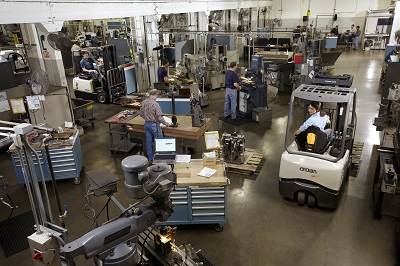Other Voices: Maintain a vibrant safety culture with a holistic approach and meaningful training
Training, connectivity, communication and continuous improvement are some of the fundamentals for lift truck safety.

Editor’s note: The following column by Melissa Fent, lift truck operator training manager for Crown Equipment Corporation, is part of Modern’s Other Voices column, a series featuring ideas, opinions and insights from end-users, analysts, systems integrators and OEMs. Click here to learn about submitting a column for consideration.
————-
As our industry celebrates National Forklift Safety Day, it is important to remember that a successful safety program must include multiple efforts that encourage forklift safety.
In fact, what is ideal is a holistic approach to safety that stresses how every individual is critical to fostering and maintaining a safe working environment. There are a variety of ways this can be accomplished, and your forklift equipment supplier can help you identify capabilities, tools and best practices that will give you a more integrated safety program.
Regardless of the approach and steps you take, there are five foundational elements of a holistic approach that you must consider.
1. Training that is accessible and extends beyond forklift operators to include managers, supervisors and other warehouse workers. Training, the core of most safety programs, is a fundamental element of the safety equation. Effective safety management requires extending training beyond forklift operators to include managers, supervisors and pedestrians, and making it readily accessible and convenient. Training, whether classroom-based or streamed online, must be interactive and engaging and tailored to the individual. It also needs to be designed to enable the manager or supervisor to positively influence safety by consistently encouraging and enforcing proper lift truck operation.
2. Connectivity that provides more visibility, awareness and opportunities to create and maintain a safe working environment. Many warehouse and safety managers are realizing that greater connectivity in the warehouse can help strengthen a safety program. The data captured brings increased awareness to operations, provides alerts and insights into impacts, and offers a new tool for identifying opportunities for supervision, reinforcement of training and positive behavioral changes.
3. Improvements that are supported by valuable data analytics that can lead to more informed ways of achieving safety goals. Real-time and historical data from forklift fleet and operator management systems are both valuable in identifying and responding to specific incidents. A real-time data approach would be getting an alert every time there is an impact above a certain threshold, or a maintenance issue that needs to be addressed. A historical data approach would be tracking the frequency of impacts to identify operators who may need additional training, or tracking certain maintenance issues to determine the pattern of occurrence for predictive maintenance.
4. Compliance management that controls access and automates processes for streamlining safety adherence. Connecting forklifts to a fleet and operator management system can also provide the ability to control access to equipment and automate processes that streamline safety compliance. Managers can limit access to operators with the required certification and training. An electronic inspection checklist can be customized with unique questions to ensure that operators have appropriately inspected the truck to ensure that it is safe to operate.
5. Equipment design that takes an operator-centric approach and prioritizes features that enable safer operation. Forklift manufacturers that take an operator-centric approach to design can address issues such as visibility and ergonomics in the design phase to help eliminate blind spots, reduce fatigue and integrate other features that enable and promote safer operation of the vehicle. Equally important is a forklift display module that delivers on-screen safety reminders and real-time coaching messaging during operation to reinforce operator training and deliver real-time feedback to operators.
Just as safety-related incidents can have multiple causes, a successful safety program must include multiple contributors to forklift safety. Forklift users should actively seek out new technologies and best practices as they become available to evolve and improve their safety programs.
By bringing together comprehensive training with safer, more ergonomic forklifts, operator and fleet management software, and safety-focused service programs, an integrated safety management program can drive measurable improvements in key safety metrics and empower individuals to consistently do their part.
For more information on forklift safety and integrated safety management, visit the new Safety and Support display in the Crown Virtual Trade Show, where among other content you can follow the introduction of each of the five chapters of our new eBook, “An Integrated Approach to Forklift Safety.”

Article Topics
Blogs News & Resources
Learn from lift truck service history Two voices of reason on pallet materials 60 Seconds with Bob Trebilcock, outgoing executive editor, Modern Materials Handling The reBound Podcast: How Pitney-Bowes is innovating with autonomous vehicles. Packaging Corner: Be open to change 60 Seconds with Robert Martichenko of American Logistics Aid Network The reBound Podcast: Looking for talent in all the right places: How Essendant is revolutionizing recruitment More BlogsLatest in Materials Handling
Geek+ and System Teknik deploy PopPick solution for pharmacy group Med24.dk Beckhoff USA opens new office in Austin, Texas Manhattan Associates selects TeamViewer as partner for warehouse vision picking ASME Foundation wins grant for technical workforce development The (Not So) Secret Weapons: How Key Cabinets and Asset Management Lockers Are Changing Supply Chain Operations MODEX C-Suite Interview with Harold Vanasse: The perfect blend of automation and sustainability Consultant and industry leader John M. Hill passes on at age 86 More Materials HandlingSubscribe to Materials Handling Magazine

Find out what the world's most innovative companies are doing to improve productivity in their plants and distribution centers.
Start your FREE subscription today.
April 2024 Modern Materials Handling

Latest Resources










